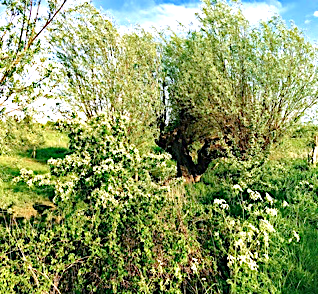Food forest versus natural forest
To get an idea of the species richness that influences the degree of biodiversity, a comparison study was conducted between two different types of forests.
The Ketelbroek Food Forest (Groesbeek), planted on a corn field in 2010, has already shown a remarkable result after six years compared to the nearby protected nature reserve De Bruuk, managed by Staatsbosbeheer.
The food forest system has more light penetration, a somewhat higher temperature, more nutrient-rich soil and a higher vegetation cover of herb and shrub layers than most traditional forests. De Bruuk mainly serves as a frame of reference for local forest biodiversity.
Despite the fact that De Bruuk is older, the food forest shows a greater biodiversity within a few years after planting. The result can be seen in the diagram above.
Source: Living nature – volume 118 – number 3 p. 90
Both research areas 2.5 hectares, standardised methods during April, May and June 2016. Research: Jeroen Breidenbach and Emma Dijkgraaf.
Organisations involved: Rich forests, Staatsbosbeheer and Food Forest Ketelbroek, Wild Life
Management, Van Hall Larenstein University of Applied Sciences – Leeuwarden.
Read more about the natural forest versus the food forest here
Initially we tend to think that the biodiversity of the older forests is great. After all, over time it has had more time to develop with regard to different biotopes. But the opposite is the case.
The differences between the forest systems of Ketelbroek and De Bruuk are now mainly in the hydrology and succession phases. De Bruuk consists of wet, older, climax forest with hay and blue grasslands and is under the influence of seepage. Ketelbroek consists mainly of young woodland and thickets with grassland and is drier than De Bruuk.
Within the De Bruuk area, a continuous plot of the same size as Ketelbroek (2.4 ha) has been selected for the study. The area has a mix of open area with grassland, thickets and forest, in keeping with the habitat mix of the Ketelbroek food forest.
Ketelbroek is a system with more light penetration, a somewhat higher temperature, more nutrient-rich soil and a higher vegetation cover of herb and shrub layers. In De Bruuk there are predominantly developed forest communities (climax forest) with more dead material and a thicker layer of litter. Soil pH measurements showed that the soil in De Bruuk is somewhat more acidic (pH 4.1-4.9) than in Ketelbroek (pH 5.6-6.0; data MSc. Thesis M. Bakker, WUR).
As an indication of the diversity of fauna, three different species groups have been standardised in the two areas: breeding birds, macro moths and ground beetles.
Source: Living nature – volume 118 – number 3 p. 90


